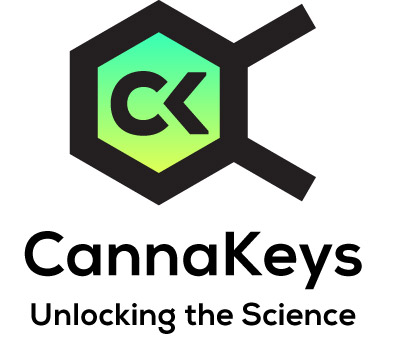When you ask Doctor Google “what is the endocannabinoid system (ECS) for?” it is often mentioned that its primary function is to establish balance or homeostasis. However, typically very little additional information is offered to tell us what this means, how it is achieved, and perhaps more importantly, why it is so important. This article looks at the involvement of the endocannabinoid system (ECS), its significance for health and well-being, and at seven practical steps we can take to support a state of optimal balance.
As is the case with any subject of complexity it is helpful to break it down into smaller more digestible pieces. First, let’s look at the definition and importance of homeostasis itself so we can move forward with the same vocabulary. Next, we’ll explore the individual components of homeostasis itself and some practical examples of homeostasis-related processes. Then, we’ll look at what can cause homeostatic malfunction, the role of the ECS in establishing homeostasis in the clinical setting, and how can we generate a therapeutic cannabis experience that will work toward homeostasis. And, finally, we’ll examine seven practical steps we can take to maximize the therapeutic benefits of cannabis constituent to support homeostasis.
What is homeostasis?
Homeostasis is an organisms’ complex ability to create and maintain optimal functioning (harmony and balance) in response to constant internal and external environmental changes.
What is the importance of homeostasis?
It can be argued that homeostasis is one of the most important functions of the human body. In fact, homeostatic failure results in loss of resilience, illness, and death. The human body contains several distinct mechanisms in all organ systems that are involved in generating and maintaining homeostasis (see graphic 2). All homeostatic regulatory mechanisms must function properly and in concert for us to be able to live, heal, and thrive.
What are the individual components of homeostasis?
It is estimated that an adult human body is comprised of 30 trillion individual cells loosely divided into 11 organ system. Embedded into the skin (i.e., the cellular membrane) of each cell are receptor sites that when activated produce very targeted effects inside and around each cell. When millions of similar cells are activated simultaneously, we experience or feel these effects such as shivering in response to cold.
The endocannabinoid system too is comprised of receptor sites (e.g., CB1, CB2), but also includes compounds that binds with them (e.g., cannabinoids such as anandamide), and the enzymes that degrade or metabolize them. Endocannabinoid-based receptor sites are arguably one of the most abundant types present in all organ systems. As such, the ECS can support, either in part or significantly, all the diverse mechanism the body relies on to (re)establish and maintain homeostasis.
Whenever change is detected by a corresponding receptor site the receptor sends a signal to the control center where the information is processed. Once the appropriate response has been determined the control center send a signal to the effector, which works to produce the change that is necessary to reestablish balance. For instance, the sun is rising and a temperature sensitive receptor site in the skin notices an increase in external temperature. A signal is sent to the control center, which determines how to maintain homeostasis by signaling the effector (i.e., sweat glands), to release water to cool the skin and as such regain an optimal temperature.
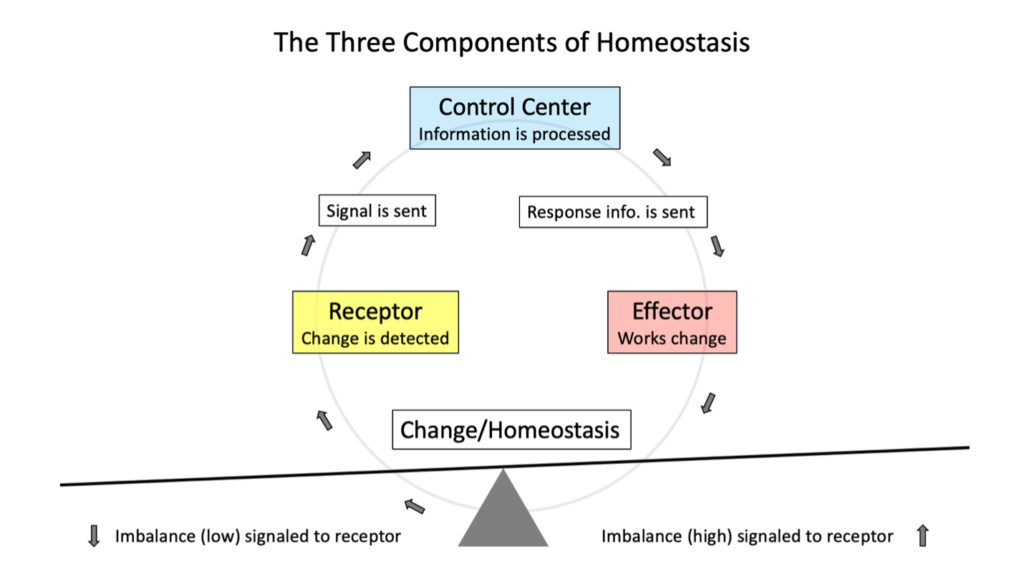
Graphic 1
Practical examples of homeostasis-related processes
A look at the graphic below shows the constant processes by which the body constantly generates (and regenerates) homeostasis. This is achieved by balancing a wide range of functions. Look at the chart below (graphic 2). In the center you’ll see the three components of homeostasis and on the left side you’ll see examples of balance markers representing the initiation of a signal based on a “too low” scale while on the right you’ll see the corresponding markers triggered by being “too high” on a scale. More specifically, indicating direct balances between acid vs base, oxidant vs antioxidant, oxygen vs carbon dioxide, cold vs warm, dehydration vs excess water, anti-inflammatory vs pro-inflammatory cytokines, glutamate vs GABA, sympathetic (fight, flight, or freeze) vs parasympathetic (rest, digest, mate, and repair) responses, stress response vs relaxation response, constricting vs expansive emotions, well-being vs stress/pain, ECS deficiency vs ECS excess, ECS tone (up) vs ECS tone (down), or blood sugar (hypoglycemia vs hyperglycemia) for example.
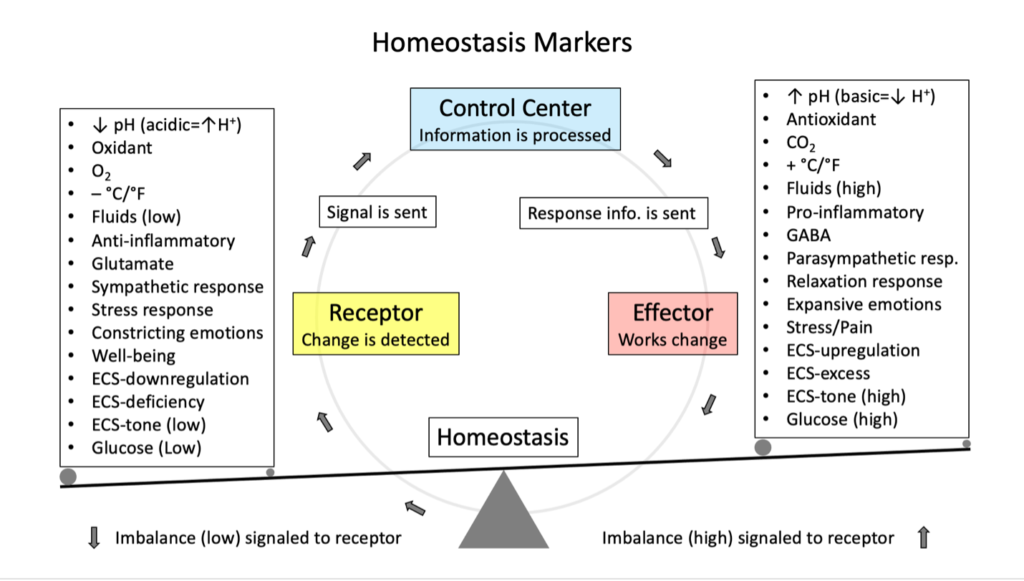
Graphic 2
What causes homeostatic malfunction?
In general, homeostasis can be impaired temporarily or permanently by factors falling into one or more of these categories i.e., lack or excess, toxins, physical or psychological trauma (e.g., stroke, acute or chronic stress respectively), and heredity (e.g., hemochromatosis causing iron-imbalances). Typically, our ability to maintain or reestablish homeostasis depends on identifying and removing a maintain cause whenever possible. Consider these common examples of how too little (lack) or too much (excess) of a thing even a basic as water, oxygen, nutrition, or sunlight can impair homeostasis, which in turn will take a significant toll on our health and well-being. Cases in point (respectively), too little water causes dehydration (we can die after 3 days without water), while too much water can cause hyponatremia (too little salt) with signs and symptoms ranging between cellular swelling, seizures, coma, and death. Too little oxygen can rapidly affect homeostasis. Try holding your breath for a while–your body will respond very quickly demanding change. On the other hand, oxygen toxicity resulting from a from scuba diving accident can cause coughing, dizziness, and convulsions. While most everybody knows that external drugs (i.e., both pharmaceutical and recreational) can severely affect homeostasis fewer may know that an insufficient amount of the body’s own and most abundant excitatory neurotransmitters glutamate can lead to brain fog or anxiety while an excess can cause excitotoxicity leading to cellular damages or death (homeostasis is achieved via inhibitory neurotransmitter GABA). Too much sunlight can cause ill-effects ranging (depending on exposure) between a sunburn, accelerated aging, or melanoma. In contrast, too little sunlight can lead to depression, weaker bones, depletion of our natural ability to convert cholesterol into vitamin D an important nutrient.
What is the role of the ECS in establishing homeostasis in the clinical setting?
To help better understand the role of the ECS in establishing and maintaining homeostasis, let’s examine its effects in the treatment context of several patient populations where homeostatic failure is considered a significant contributing factor such as diabetes, renal failure (hemodialysis), sepsis, and those who have survived a recent cardio-pulmonary resuscitation and resulting reperfusion injuries.
Diabetes: Being too sweet or not sweet enough is one of the central homeostatic challenges facing the diabetic patient. Over forty primary trials and two clinical studies trials have been conducted looking at cannabis constituents in the context of treating diabetes. Collectively data suggests several mechanisms by which modulating components of the ECS may produce relevant homeostatic effects include improved metabolic function, reduced insulin resistance, reduced obesity rates, improved lipid, and glycemic parameters, reduced pancreatic inflammation, reduction in autoimmune dysfunction, anti-oxidative properties, and reduction in diabetic co-morbidities (e.g., heart disease, obesity, neuropathies) for example.
The human trials have focused on the general effects of hemp protein consumption and two cannabinoids i.e., THCV and CBD on diabetic patients. The hemp protein lowered post-prandial blood glucose and insulin concentrations (in a dose-dependent fashion) and as such supports the body in glucose homeostasis. THCV is an emerging cannabinoid that may provide patients with additional homeostatic benefits.
Renal failure: Homeostatic failure secondary to kidney failure results in the accumulation of waste products, shifts in fluid balance, and a severe imbalance of electrolytes for example. Modern medicine is addressing this lack of homeostasis by filtering the patient’s blood using an artificial kidney or hemodialysis machine.The currently available scientific literature examining the modulation of components of the endocannabinoid system (ECS) in the treatment of kidney failure is limited to its pre-clinical stage and as such offer limited guidance. However, data shows that CBD treatment produced significant protection against acute kidney injury in test animals. More specifically, CBD treatment preserved mitochondrial membrane potential, reduced cell death and kidney injury molecule-1 accompanied by restoration of neutrophils (with pro- and anti-inflammatory functions) imbalance and preservation of regulatory T-17 (Treg17) cells that curtail T helper 17 (Th-17)-mediated pro-inflammatory responses and as such contribute to homeostasis during inflammatory processes.
Sepsis: It may surprise you to learn that sepsis is the number 10 cause of death in the US.1 In sepsis, homeostatic immune system failure results in an either overactive or ineffective immune response also referred to as blood poisoning. Controlling sepsis is a significant challenge and new and more effective treatment or prevention option would surely be appreciated by physicians and patients alike. However, the current understanding of ECS-based effects in the treatment of sepsis is currently only in their pre-clinical stage. Over a dozen of trials have directly examined components of the ECS with relevance to the underlying pathologies of sepsis. For instance, researchers discovered higher level of the endocannabinoids anandamide (AEA) and 2-AG in patients with endotoxic shock than in healthy persons. The ECS has emerged as a potentially novel target system in cases of immune compromised sepsis primarily posited to be due to CB2-induced effects on the immune system. However, the utilization of cannabinoid-based therapeutics may be detrimental if not appropriately aligned with the two phases of sepsis. The differential modulation of CB2 (via CB2 agonism and antagonism respectively) during the two contrasting phases of sepsis are imperative and, which are currently held as the early hyperactive immune phase of sepsis (e.g., hyper/pro-inflammatory, excess of pro-inflammatory cytokines) and the typically later occurring hypo-immune phase where the patient’s immune system is overwhelmed by microbial invaders. ECS-based effects generated via CB2 agonism may reduce the over-reactive inflammatory response during the early phase of sepsis, while antagonism of CB2 during the later phase may help reduce mortality by supporting the immune system in eliminating pathogens. In addition, endocannabinoids, and modulation of CB1 (most likely via antagonism) may play an important role in the initial phase of septic shock. Several cannabis-based constituents (e.g., CBD, beta-caryophyllene), endocannabinoids (i.e., AEA, 2-AG), as well as synthetic cannabinoids (e.g., HU-211) may have future therapeutic implications.
Reperfusion injury: When the whole, or parts of the human body, are deprived of blood supply and is reanimated (e.g., after successful CPR, stroke, crush injuries) the returning blood supply can cause additional tissue damage referred to as reperfusion injury further complicating patient recoveries. Diverse bodily function that you have seen in the homeostasis marker graphics come to play a role including oxidative vs antioxidative effects, pro- vs anti-inflammatory, and/or acids vs base for example. Depending on severity recovery can be a severe and long-term challenge for both patient of caretakers alike. As such any novel potentially, therapeutic approaches are needed.
However, only twenty-three pre-clinical trials have directly examined the modulation of components of the ECS in the treatment context of reperfusion injury and as such only provide us with limited guidance. Receptor sites implicated in activating potential therapeutic effects include CB2, GPR55, TRPV1, and 5-HT1A (serotonin). Cannabinoids utilized in these trials included primarily CBD but also JWH-133, O-3853, O-1966, Δ8 -THCV (a synthetic analogue of the plant cannabinoid Δ9 -THCV), and the endocannabinoids anandamide and its degrading enzyme FAAH.
A look at the graphic below will give you an overview of the far-reaching effects of the ECS on various homeostatic functions. More specifically, look at the parenthesis after most of the homeostasis markers listed and you will find the specific endocannabinoid receptor sites (i.e., CB1 and CB2) that are implicated in modulating their respective homeostatic functions.
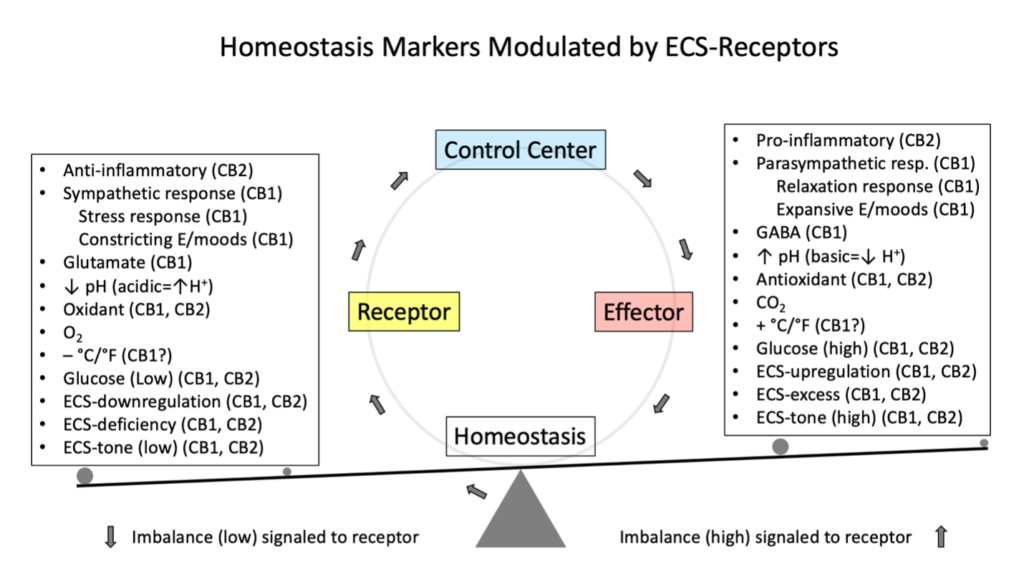
Graphic 3
Generating a therapeutic cannabis experience toward homeostasis
A therapeutic cannabis experience generates optimal patient outcomes, provides predictability of effects, and reduces in the risk of any adverse effects. It is based on insights gleaned from one or more of three areas of knowledge: the patients’ preferences about what kind of cannabis experience they wish to have (e.g., do I want changes in cognition or not), an evidence-based review of the relevant scientific literature, and health care providers clinical judgment and experience.
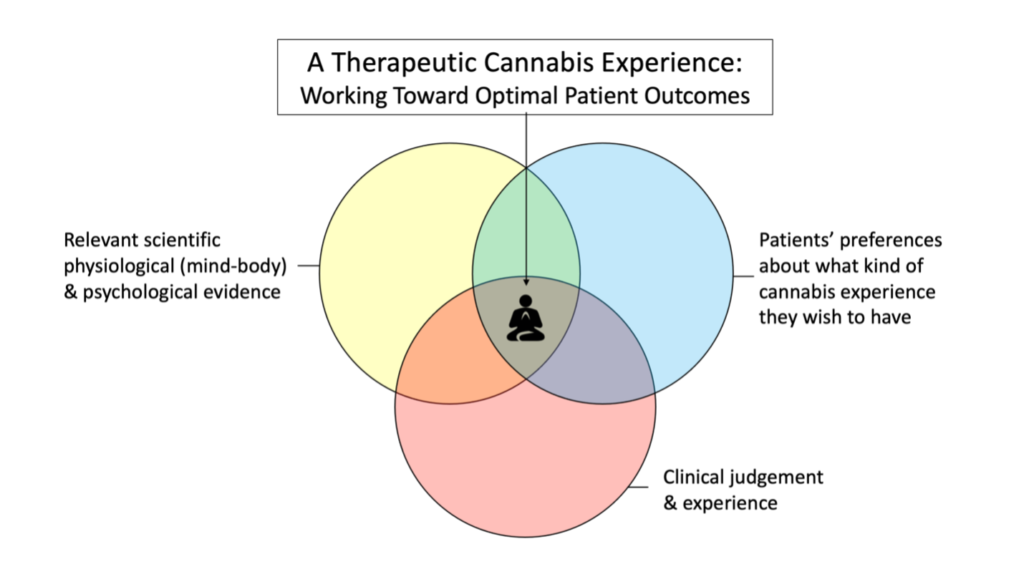
Graphic 4
Seven practical steps we can take to maximize the therapeutic benefits of cannabis constituent to support homeostasis.
Carefully selected and crafted cannabis-based medicine, especially those that are flower derived and contain all the plant’s constituents (full spectrum products), those that are grown organically (free from harmful pesticides or pathogens), and those that are lab-tested (so we can use them with precision) can induce complex cascading effects that work in concert to create optimal treatment synergies.
Several things that cannot be controlled such as for instance:
- The state of the patient’s endocannabinoid tone and/or the presence of any endocannabinoid deficiencies
- The number of cannabinoid receptor site expressed in affected tissues (which can vary depending on phase of condition and can vary even within the same patient population)
- The speed with which a cannabinoid crosses the BBB
- The speed of 2nd pass metabolization (in the liver)
Seven steps we can take to generate a therapeutic cannabis experience.
- Choose a primary cannabinoid (e.g., CBD)*
- Secondary Cannabinoid (e.g., THC)*
- Sub-Ratio (between primary and secondary cannabinoid)*
- Dosages (in mg)*
- Form (e.g., inhalation vs ingestion)*
- Entourage Effect (e.g., terpene)*
- Session Log (to monitor precise shifts and changes based on)
*based on the patient’s preferences, scientific evidence and clinical experience/judgment
In summary, choosing the right type of cannabis, using it at the proper dose, in its optimal form, and matched to the unique needs of each individual patient can work very effectively toward multiple system homeostasis by inducing a sense of deep relaxation (relaxation response), mitigate the ill-effects of stress (both mental and oxidative), induce a gentle uplift in mood, and reduce or alleviate various types of pains all at once.
Endnotes:
1. Martin GS, Mannino DM, Eaton S, Moss M. (2003 Apr 17) The epidemiology of sepsis in the United States from 1979 through 2000. N Engl J Med. 348(16):1546-54.


